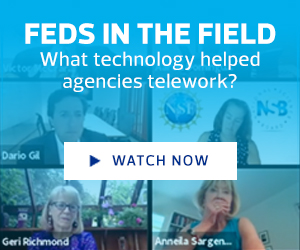We also very rapidly implemented and adopted an electronic document signature and routing methodology. It’s for anything you want to send throughout your organization to various people for their approval and review, and finally an electronic signature. I look a lot at procurement docs. As CIO, I’m responsible for IT purchases, performance reviews. These require internal signatures and external signatures. We work continuously to modernize, so we always have new products in development and moving to production. This document signature product was ready to move to production as we transitioned to 100 percent telework, and we expedited implementation.
MORE FROM FEDTECH: How to ensure your VPN can handle work-from-home traffic.
FEDTECH: How are you ensuring cybersecurity during a massive increase in telework?
ARONSON: We’re still using multifactor authentication. The thing we’ve become more aggressive about is remotely patching workstations. We’ve increased our ability to remotely patch devices, whether or not they’re on the VPN. We used to rely on the VPN as the conduit to push these patches out. We have gone to more frequent patching of remote devices, and we’ve found a way to do that with more agility, using cloud capability.
FEDTECH: What were you expecting in terms of employee productivity when you made this transition, and how did those expectations match reality?
ARONSON: I knew that people would be able to use the technology. I didn’t know about the impact of things like fear, having relatives who were ill, worrying about your own relatives — all of those things are very scary. NSF’s leadership has been incredibly gracious, right from the very beginning, because they have put the staff first. In a very stressful situation, they have really helped us make this transition.
I think people love to work. What I saw in the first few weeks was people just working endlessly, not being able to sleep, because of all the things they were worried about at work. They wanted things to carry on as if nothing was going on, almost. Things have relaxed since then, but when we ask people, “You’ve been working really hard. What would you like to give up?” people are very reluctant to give things up. I’m not a psychologist, but I believe work is a distraction. People want to focus on things they can manage and control in a world that’s full of uncertainty. I’ve been on many Zoom calls where toddlers or kids come in. I’m getting to know all of those people. And I like it. I believe it’s an enriching experience to be in a natural work environment, like working from home. That’s been my experience.
FEDTECH: Do you see telework expanding once things are back to “normal”?
ARONSON: Oh, yeah. I was one of these people who never teleworked. All of my work is with people. I felt there was no way I could take that home. Having everyone telework teaches all of us doubting Thomases that, in fact, it’s an incredibly productive environment. And it can continue, and it should continue. And we shouldn’t necessarily be stressing people out with two-hour commutes in each direction. In my view, we will maximize people’s productivity going forward if we — I’m not even saying “if” — when we go toward the future, there’s going to be much more telework. A great thing about that is we can recruit people from across the country. We don’t have to focus so much on our immediate vicinity, and people don’t have to live within the Beltway to have a job supporting NSF.
I think the most important thing is, we don’t know what the future is going to bring. What we do know is that we can be flexible and responsive. We have to try to imagine the future so we can prepare for that, but we also have to understand that the future we’re imagining is not the future we’re going to get.
READ MORE: Learn how to make federal telework a long-term success.









.png)



